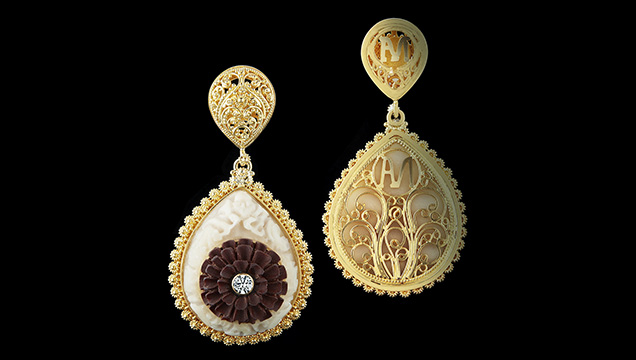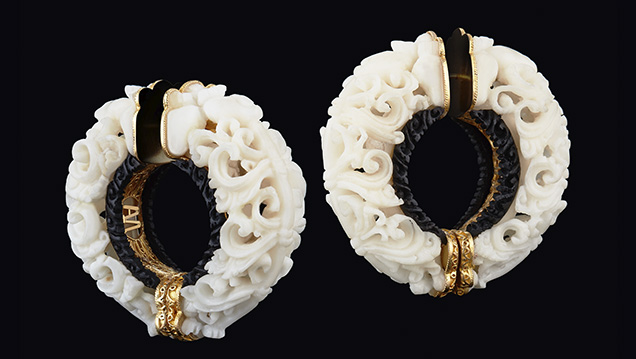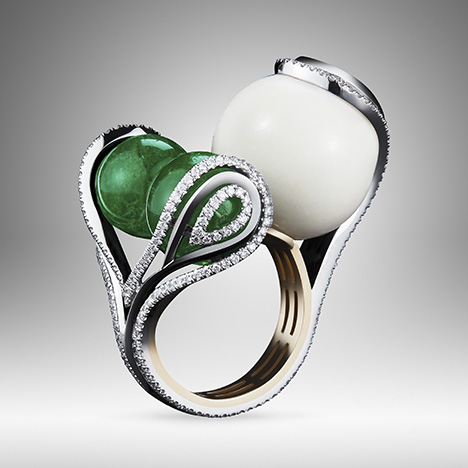Tagua Nut as a Sustainable Botanical Alternative for Ivory

Award-winning haute couture jewelry designer Alexandra Mor considers sustainability a way of life. When designing her one-of-a-kind pieces, she is mindful of her client’s lifestyle and interests while also thinking of the environment and of the culture and well-being of the artisans who bring each object to completion. It is in this spirit that she created the Tagua Collection, which uses the endosperm of the ivory palm tree—also known as the tagua nut or tagua seed—as an elephant ivory substitute. Now she is expanding into 3D printing using tagua nut specimens.
Mor, who believes that “designers are the new activists,” is not new to ethical or sustainable jewelry design. In 2013, she created a ring (later modeled by actress Mila Kunis) using ethically sourced emeralds, the same year she won the Fashion Group International Rising Star Award. But Mor wished to create a more meaningful, spiritual, and eco-conscious practice of her own. Concerned about the plight of elephants and the continued use of ivory in jewelry, she was inspired to use the tagua nut as a botanical alternative. Mor, who was influenced by Balinese philosophy, chose to ethically source the tagua nuts from Ecuador and Colombia and create the collection in Bali. She worked for 10 months with carvers and master goldsmiths to create the pieces, which are rich in local cultural motifs and Buddhist symbolism. Balinese designs found in this collection include the vines, leaves, and tendrils seen in the gold work of the tagua seed, wood, and diamond earrings (figure 1); these are often seen on the island’s temples. The kayonan, or tree of life, motif is carved into the tagua nut sections of the earrings in figure 2.

The Tagua Collection has been well received among collectors and in the trade. The introduction of a new and sustainable fine jewelry material, at a time when clients seek out such goods, has been an inspiration to others, and Mor was named Town & Country’s Fine Jewelry Innovator of the Year for 2018. Since 2016 she has directed Vogue Italia’s The Protagonist at Christie’s New York, a competition in which 14 designers use sustainable materials such as reclaimed gold and wood, vegetable leather, and responsibly mined gemstones alongside the tagua nut. Mor’s work has also drawn attention outside the industry, allowing opportunities to expand her work. At the 2018 Gem & Jewellery Export Promotion Council (GJEPC) meeting in Mumbai, she met Kamlesh Parekh of Imaginarium, India’s largest 3D printing company. After touring their facilities with Parekh, Mor believed she had found a way to overcome the small size of the tagua seed, a major limitation. She gave Parekh three seeds to test, and Imaginarium has produced the first 3D-printed tagua nut. Such production will allow for larger, more plentiful tagua pieces in the future.
Mor’s next collections will continue to use tagua seeds, as well as sustainably sourced precious metals and conflict-free diamonds, and she will continue to collaborate with Colombia’s Muzo mine due to their social and environmental commitment (figure 3). She supports Space for Giants, a conservation organization dedicated to protecting elephant habitats. She has also launched the Tagua Foundation, which is dedicated to inspiring young designers and leaders, as well as students of all ages, to create sustainable jewelry. Mor explained, “As designers, we have a responsibility to what materials we are using, and as collectors of fine jewelry, we have a voice and can make a difference in how we purchase. I have decided to use my voice to lead and inspire the fine jewelry industry to take the necessary steps to care for our planet and its people through grace and education. It doesn’t matter what we choose to do, what matters is that what we choose will make a difference.”




